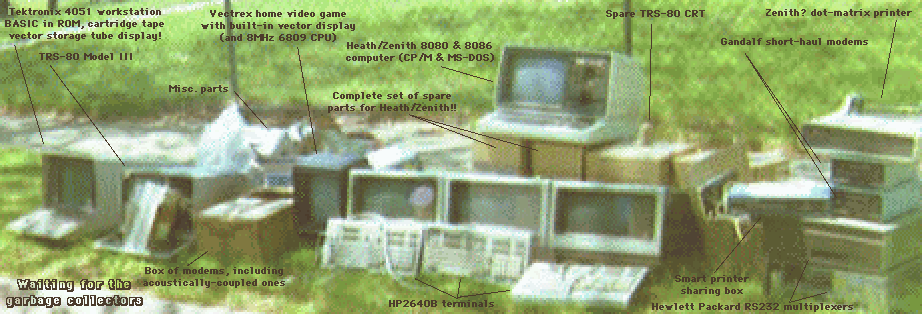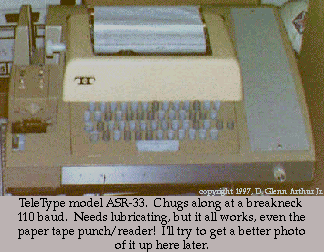 copyright 2001, D. Glenn Arthur Jr.
copyright 2001, D. Glenn Arthur Jr.
![[What's new at this site]](http://www.kempt.net/~glenn/bang1.gif) Last updated 1999.
Last updated 1999.![[ About Donations ]](http://www.kempt.net/~glenn/dbutton2.gif)
 copyright 2001, D. Glenn Arthur Jr.
copyright 2001, D. Glenn Arthur Jr.
![[What's new at this site]](http://www.kempt.net/~glenn/bang1.gif) Last updated 1999.
Last updated 1999. |
![[ About Donations ]](http://www.kempt.net/~glenn/dbutton2.gif) |
 Not shown in this photo are a sizeable stack of IBM PC and PC/XT (and
clone) cases, some of them with the computers still inside, a couple more
printers (Epson FX-100 (needed a new paper-advance motor) and Nec Pinwriter
P7 (somewhat gunked up)) and the A/D converter from a 1969 Varian
minicomputer. (The rest of the Varian, except for the rack, was thrown out
in the previous move.)
Not shown in this photo are a sizeable stack of IBM PC and PC/XT (and
clone) cases, some of them with the computers still inside, a couple more
printers (Epson FX-100 (needed a new paper-advance motor) and Nec Pinwriter
P7 (somewhat gunked up)) and the A/D converter from a 1969 Varian
minicomputer. (The rest of the Varian, except for the rack, was thrown out
in the previous move.)
*sigh*
The Tektronix 4051 was a cute beast with a vector storage tube display. That means two things -- that it drew pictures with individual lines from point to point instead of lots of little dots (that's the "vector" part); and that the screen did not have to be redrawn every 30th of a second (that's the "storage tube" part). So no "jaggies" and no flicker. The downside is that to erase any part of the screen required erasing the whole screen and starting over. But if you wanted a complicated, detailed, line drawing with real straight lines, it was great. Old fogeys and ancient-hardware enthusiasts know what a vector display and storage tube are, but I realy liked having one on hand to demonstrate to everyone else! Especially since folks tend to look at me like I'm nuts when I describe it. *sigh*
The Vectrex (I have another one, which I kept) is a home video game that never quite caught on. Instead of hooking to a television set it had its own built-in display. Why? Because it too was a vector display. Unlike the Tektronix 4051 it was not a storage tube -- it had to continually redraw the screen just like a television or a conventional raster computer monitor. If there were too many lines on the screen to keep up with, it took longer to redraw the screen and it would flicker slightly. But as you might expect with a video game, this also meant that the pictures could move. It's a rather spiffy little box. If you remember Asteroids in the arcades, that used a vector display as well. The home version of Asteroids drew pictures on a television and did not look anything like the arcade version. The game "Mine Storm" for the Vectrex did look a lot like arcade Asteroids (though it played differently). There was also a light pen for the Vextrex (I have one) so you could draw your own designs. The one I threw out had a fault in its vertical deflection coil. If I could have found that one spot and soldered it, the thing would have worked just fine. Fortunately I've still got a working one...
The HP2640B terminals weren't especially nifty in their own right (though I did rather approve of the modular (and easily-serviced) hardware design), but I really hated to throw out perfectly good, working terminals. Two of the three worked -- I'd been keeping the third for spare parts, just in case.
The TRS-80 Model III ... well you either think they were nifty or you don't. I do. I learned BASIC on a Model I at school, and the first computer I owned was a Model III. The one shown in this photo was gutted before I threw it away, just in case the one I kept ever needs a new power supply or CPU board. At one time I had three of them. When I had a cassette-only machine I bought a graphics board (despite Tandy's statement that the graphics board required a floppy-equipped machine). It worked just fine, thank you very much, though of course I couldn't use any of the utilites supplied on diskette or the graphics extensions to disk-BASIC. When I later got another Model III that had diskette drives, I didn't want to open the case before the warranty expired. Instead I ran a 50-conductor ribbon cable between the two computers, told the one with the graphics board installed to ignore it, lied to the one with the floppies and told it that it had a graphics board in it, and when I switched to hi-res mode I still had my text screen visible on the floppy machine while my graphics appeared on the cassette machine. Personally, I thought that was pretty darned cool!
When I have time (next couple of days) I'll add some descriptive text explaining particular niftinesses of the rest of the machines.
I did keep the Televideo 925, a 386, a 286, and one each of TRS-80 Model I, Model III, and Model 4. And the ASR-33 Teletype.

 |
|
 |
||
![[ About Donations ]](http://www.kempt.net/~glenn/dbutton2.gif)
|
